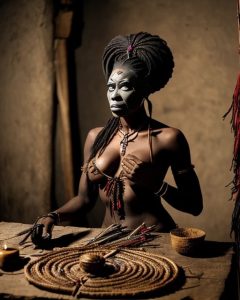Voodoo’s enigmatic allure has always mesmerized Western minds. Usually, in popular culture, it would be expressed as a dark and mysterious practice surrounded by witchcraft and curses. What we see in media explications is pretty much misleading. Indeed, what hides under, is a deep treasure about spiritual traditions. Emerging from Africa and transformed by the harsh conditions of slavery and colonialism in Haiti and other areas of the Americas, voodoo has played a crucial role in the cultural expression and resistance of many communities. This essay will make the case that the story of voodoo is not simply a matter of exotic enchantment but a multifaceted, profoundly misunderstood form of cultural expression that Western societies have cruelly maligned. This essential analysis strives not only to reveal the true nature of voodoo by removing years of misunderstanding, but also to emphasize its vital function as a reservoir of strength and perseverance for those who practice it.
Expanding on this line of thought, it is vital to acknowledge that the slandering of voodoo is not due to its fundamental characteristics, but it is due to a serious distortion of facts and ignorance in Western societies. In his work, Anderson argues that newer views of voodoo are not seeing the whole picture of the ritual. In supplement, Anderson states that this view of voodoo is more of a media myth of voodoo than the basic reality based on the years of tradition. The distorted outlook has allowed for a story that ties together voodoo first and foremost to hazardous wizardry and uncanny jinxes, leaving no thought to its genuine nature as an intricate faith teeming with ceremonies, icons, and a sense of fellowship and holiness that is deeply embedded. Through involving modern theories about voodoo and hoodoo in his examinations, Anderson highlights the significance of fitting these habits into their appropriate social and historical structures. This method not only started to make voodoo clear to everyone, but also stated its position first as a way of combating oppression, and thus began to question colonialist ideas which were causing bias. Later in this research, we understood that to really appreciate the complexity and width of the history of voodoo we need to look beyond maids and bottle washers painted by some series.
Expanding upon Anderson’s criticism of the Western societies’ overly simplified and sensationalist perspectives, SL Kwosek’s 2019 research study reinforces the idea that voodoo has become a general religion among people in areas, especially New Orleans. It has become deeply embedded in the traditions and practices of various cultural and sociopolitical communities, going beyond the misconceptions that have generally negatively described it.” As described by Kwosek, voodoo in New Orleans not only gained significance and infamy but also joined forces as a booming practice that gathered public endorsement and approval (Kwosek, 2019). This change was in part a result of captivating voodoo community leaders who exerted themselves to redefine it from an enigmatic collection of rituals to a systematized assemblage of faith with public gatherings and leader lead prearranged religious services. In reference to the passage you provided, I would rephrase it as follows: The transition illustrated in the content signals a type of cultural fortitude and acclimation, decidedly subjective to the usual descriptions that voodoo has acquired. These persistent stereotypes include it as no more than ancient or simply frightful. According to Kwosek’s exploratory examination, voodoo suffers down to a future of ultimacy, which corrects that very prolonged supposition. Their activity over the years, as Voodoo Cocoa signifies, contributes to falsify or render inoperative the Western conclusion of their religion.
Examining voodoo from its distorted portrayal in Western society to its accurate representation as a complicated, influential religious practice highlights a wider story of the ability of a culture to recover from and deal with difficulty. Voodoo is often stereotyped as a dangerous and evil practice in the media. However, voodoo is deeply embedded in the cultural heritage of societies that have often been oppressed and provides a sense of community strength and personal empowerment to those who practice it. Anderson and Kwosek’s observations point out how placing voodoo within its historical and cultural confines not only debunks falsehoods but also emphasizes how voodoo worked as a means of bucking the system and enduring cruelty. Acknowledge these aspects will lead to a more profound involvement with and reverence for religious rituals that are frequently ignored or misinterpreted. As society progresses, it is essential to push for more investigation that uncovers the intricate depths of voodoo. This research should aim to prompt discussions that cultivate comprehension and break down the deep-rooted prejudices we hold, helping us move closer to appreciating the various spiritual frameworks that mold our worldwide background.

